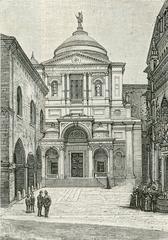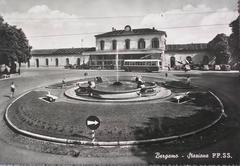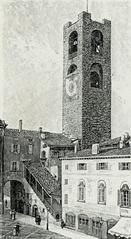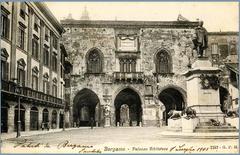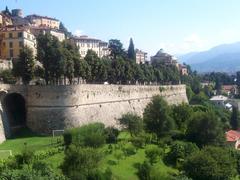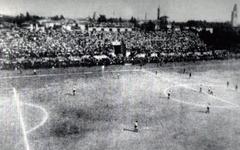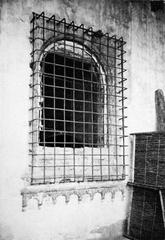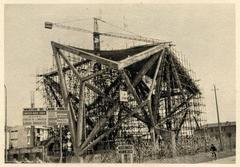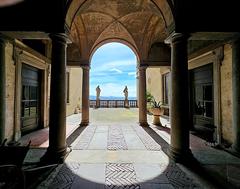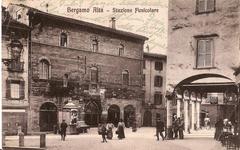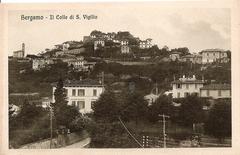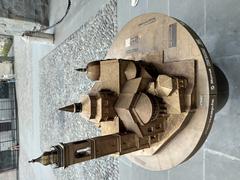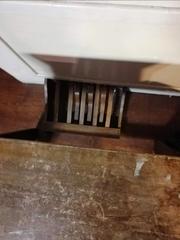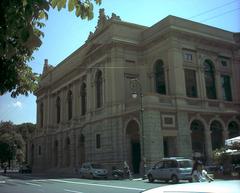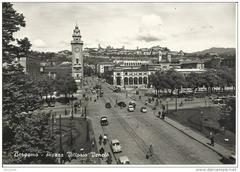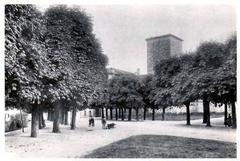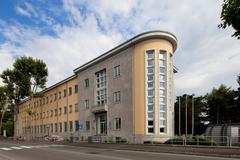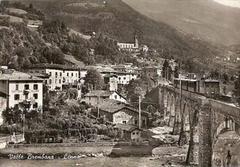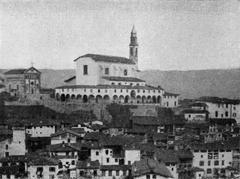
Sant Andrea Bergamo Italy: Visiting Hours, Tickets, and Historical Sites Guide
Date: 04/07/2025
Introduction
Sant’Andrea Church in Bergamo is a remarkable testament to the city’s deep religious and artistic traditions. Nestled in the heart of Bergamo’s Città Alta, this neoclassical monument, reconstructed in the 19th century atop ancient Christian foundations, offers visitors a unique journey blending spiritual, cultural, and educational experiences (visitbergamo.net). Its incomplete neoclassical façade and majestic dome are emblematic of Lombardy’s architectural ambitions during a period of historical transformation (Lombardia Beni Culturali).
Sant’Andrea houses an outstanding collection of Renaissance and Baroque masterpieces, including works by Il Moretto da Brescia and Andrea Previtali, underscoring its significance as a guardian of Bergamo’s artistic heritage (Wikipedia; eventbrite.it). As an active place of worship, a museum, and a venue for art and theater, Sant’Andrea is both a historical sanctuary and a vibrant hub for community engagement.
This guide provides comprehensive information for travelers—including visiting hours, ticket details, accessibility, and travel tips—making Sant’Andrea an essential stop when exploring Bergamo’s historic sites and cultural landmarks.
Table of Contents
- Welcome to Sant’Andrea Church in Bergamo
- Origins and Historical Evolution
- Neoclassical Architecture and Artistic Heritage
- Spiritual and Cultural Significance
- Visitor Information: Hours, Tickets, and Accessibility
- Events, Photographic Spots, and Travel Tips
- Sant’Andrea’s Role in Bergamo’s Urban and Cultural Landscape
- Practical Visitor Information and Nearby Attractions
- Frequently Asked Questions (FAQ)
- Conclusion and Call to Action
- References
Welcome to Sant’Andrea Church in Bergamo
Located within Bergamo’s Città Alta, Sant’Andrea (St. Andrew the Apostle) offers a unique blend of historical depth, architectural beauty, and artistic richness. Whether you are passionate about history, art, or spiritual reflection, Sant’Andrea promises an immersive experience in one of Lombardy’s most picturesque cities.
Origins and Historical Evolution
The current neoclassical structure of Sant’Andrea was erected between 1837 and 1847 under architect Ferdinando Crivelli, replacing an older cemetery basilica that itself stood on even earlier Christian foundations (visitbergamo.net). This evolution reflects Bergamo’s centuries-old religious continuity and adaptability to changing artistic and architectural styles.
Sant’Andrea’s historical tapestry is enriched by its association with prominent artists, such as Andrea Previtali, whose Renaissance masterpiece “Compianto sul Cristo morto” remains a focal point for art lovers and scholars alike (eventbrite.it).
Neoclassical Architecture and Artistic Heritage
Unfinished Facade: A Monument to History
Sant’Andrea’s most distinctive exterior feature is its unfinished neoclassical façade, envisioned with a grand portico inspired by monumental Italian and Russian ecclesiastical architecture (Lombardia Beni Culturali). Only the three portals, crafted in white Zandobbio marble, were realized, leaving six pilasters that hint at the original design (Academia.edu; Prima Bergamo). This unfinished state has become an integral part of the church’s identity and intrigue.
Interior and Artistic Treasures
Inside, three naves are separated by Corinthian half-columns, leading to a hemispherical dome elegantly adorned with trompe-l’oeil coffering (Visit Bergamo)). The apse is decorated with frescoes by Gian Battista Epis, providing a vibrant setting for the high altar (Prima Bergamo).
Sant’Andrea’s art collection includes:
- “Enthroned Madonna with Child and Saints” by Il Moretto da Brescia—an exquisite Renaissance altarpiece (Wikipedia)
- “Compianto sul Cristo morto” by Andrea Previtali—a moving depiction of mourning over Christ (eventbrite.it)
- Works by Palma il Giovane, Salmeggia, Padovanino, and others, representing the rich tapestry of Renaissance and Baroque art
- A prestigious Serassi organ, emblematic of Bergamo’s musical tradition (Prima Bergamo)
Many of these masterpieces were transferred from earlier iterations of the church, illustrating Sant’Andrea’s enduring role as a steward of sacred art.
Hypogeal Level and Adaptive Reuse
Beneath the church, the hypogeal crypt has been transformed into the S. Andrea Theater, a cultural venue for performances and university events, furthering the church’s integration into modern community life (Visit Bergamo); Italyscapes).
Spiritual and Cultural Significance
Sant’Andrea is both a spiritual anchor and a cultural hub. In addition to its liturgical role, it houses the Museum of History and Sacred Art and the St. Andrew’s University Center. These spaces foster academic, artistic, and community activities, making Sant’Andrea a living monument in Bergamo’s urban fabric (visitbergamo.net).
Visitor Information: Hours, Tickets, and Accessibility
Visiting Hours
- Monday to Saturday: 9:00 AM – 6:00 PM
- Sunday and Public Holidays: 10:00 AM – 5:00 PM
- Closed on major religious holidays (check the official website for updates)
Tickets and Admission
- Church entry: Free
- Museum of History and Sacred Art: €5 general admission; discounts for students, seniors, and groups
- Guided tours: Available by appointment; recommended for an in-depth experience
Accessibility
Sant’Andrea is accessible to visitors with disabilities. Ramps and assistance are available on request. The museum and theater are similarly equipped, and tactile models support guests with visual impairments (Academia.edu).
Events, Photographic Spots, and Travel Tips
- Events: Concerts, art workshops, and theatrical performances are held throughout the year in the church and crypt theater.
- Photography: The façade, dome, and main altar offer excellent photo opportunities. Photography without flash is permitted, except during services or performances.
- Travel Tips: Arrive early or late in the day for a quieter visit. The church is a short walk from the Città Alta funicular and close to major attractions like Piazza Vecchia and the Basilica di Santa Maria Maggiore (planetware.com).
Sant’Andrea’s Role in Bergamo’s Urban and Cultural Landscape
Sant’Andrea is integral to Bergamo’s network of historical religious sites. While not as famed as the Basilica di Santa Maria Maggiore or the Colleoni Chapel, it offers a more intimate setting for art appreciation and reflection. Its adaptive reuse as a museum and theater further cements its status as a bridge between Bergamo’s past and present (in-lombardia.it; eventbrite.it).
Practical Visitor Information and Nearby Attractions
- Location: Via Porta Dipinta, Bergamo Città Alta. Easily reached via funicular from Città Bassa.
- Parking: Limited in Città Alta; recommended to park in Città Bassa and walk or take the funicular (Bimbe in Viaggio).
- Nearby Attractions: Piazza Vecchia, Basilica di Santa Maria Maggiore, Colleoni Chapel, and the UNESCO-listed Venetian Walls (planetware.com; Milano Zone).
- Family and Accessibility: Steep, cobblestone streets may challenge strollers; baby carriers preferred. Facilities nearby include public restrooms and tourist offices.
Frequently Asked Questions (FAQ)
Q: What are the Sant’Andrea Church visiting hours?
A: Monday to Saturday, 9:00 AM–6:00 PM; Sunday, 10:00 AM–5:00 PM. Check official updates for holidays.
Q: Is there an entry fee?
A: Church entry is free; the museum charges a small admission fee.
Q: Are guided tours available?
A: Yes, by prior arrangement.
Q: Is Sant’Andrea accessible for people with disabilities?
A: Yes, with ramps and assistance available.
Q: Can I take photos inside the church?
A: Photography without flash is allowed except during services or performances.
Q: Where can I park?
A: Limited parking in Città Alta; park in Città Bassa and use the funicular.
Conclusion and Call to Action
Sant’Andrea Church is a hidden gem, offering a rich encounter with Bergamo’s religious, artistic, and architectural heritage. Its unfinished façade, monumental dome, and precious artworks make it an essential stop for anyone interested in Italian history and culture. With free entry, accessible facilities, and a central location, Sant’Andrea is ideal for both spontaneous visits and in-depth explorations.
For current visiting hours, guided tour bookings, and event updates, visit the official Bergamo tourism website. To further enrich your visit, download the Audiala app for guided audio tours, real-time updates, and travel tips. Follow us on social media for exclusive content on Bergamo’s cultural treasures.
References
- Sant’Andrea Church in Bergamo: Visiting Hours, Tickets, and Historical Insights (visitbergamo.net)
- Visiting Sant’Andrea in Bergamo: Architectural Highlights, Art Masterpieces & Visitor Information (Lombardia Beni Culturali)
- Sant’Andrea in Bergamo: Visiting Hours, Tickets, and Cultural Highlights (eventbrite.it)
- Practical Visitor Information (visitbergamo.net)
- Bergamo Historical Sites Overview (planetware.com)
- Polittico di Sant’Andrea (Wikipedia)
- Sant’Andrea, Bergamo (Wikipedia)
- La chiesa di Sant’Andrea in Bergamo Alta: Storia e ricostruzione digitale della facciata incompiuta (Academia.edu)
- La chiesa di Sant’Andrea (Prima Bergamo)
- Church of Sant’Andrea (Italyscapes)
- Chiesa di S. Andrea Apostolo (Visit Bergamo)
- Churches in Bergamo (in-lombardia.it)
- What to see in Bergamo: itinerary and map (Bimbe in Viaggio)
- 15 Best Things to Do in Bergamo (The Crazy Tourist)
- Bergamo complete travel guide 2025 (Milano Zone)






